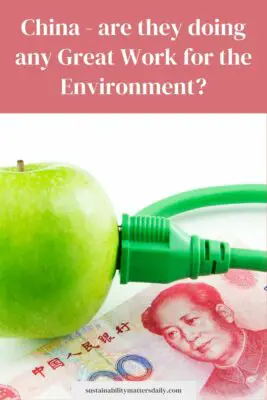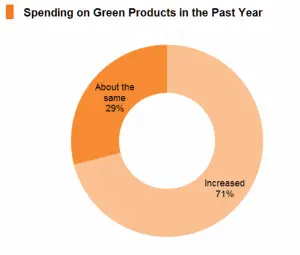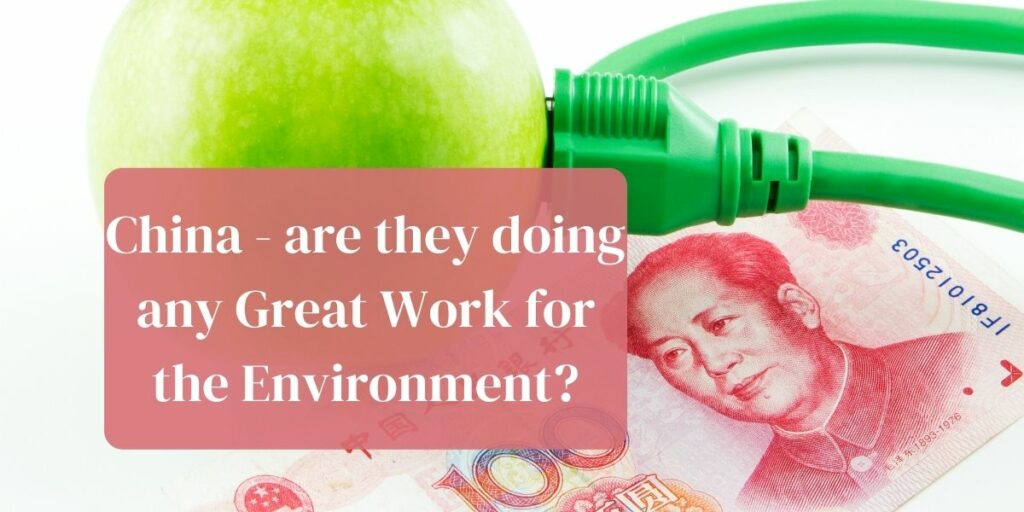After living in China for five years, I am quite knowledgeable about what happens in this gigantic country. When you combine the experiences I got from the last five years with my strong interest in environmental politics, you end up with an article like this. I am to make it well-written, educational, un-biased and without any political references (therefore, please read on…).

Table of Contents
- “Is China really an eco-friendly country? Are you sure?”
- Ten ways China is contributing to a greener planet
- How can I learn more about the environmental actions taken by the Chinese government?
“Is China really an eco-friendly country? Are you sure?”
Some people might go mental in the comment section with stuff like “China does nothing good for the environment, it’s all scam and propaganda!” and stuff like that.
That`s fine.But this is not an article that is written to show any bad sides of China . This is an article featuring how the government in many ways try to deal with their high CO2 emissions – and I want to create a positive article about how China contribute to an environmentally friendly planet. As everything we hear about is the bad smog in big Chinese cities, I was thinking to balance that out a bit.
If you want to know more about how it is to live in the Beijing air pollution, I can strongly recommend this article. In that article, I describe everything you need to know about the air pollution. How my body struggled, how I saw friends who struggled, unique pictures from smog-heavy and smog-free days, etc.
All references and statements in this article have been double-checked by credible, independent sources.
Ten ways China is contributing to a greener planet
I will first present you with the list. If you want to read more about ever point, you would have to scroll down to find more information (which I would really recommend).
1. Active desert greening (with example from Kubuqi)
2. Aggressive renewable energy investments
3. Innovative electric car solutions
4. Banning coal-fired powerplants around large cities
5. Recycling activities implemented in several cities (Shanghai example)
6. An awful lot of money invested in subway/metro infrastructure
7. Electric buses (with an example from Shenzhen)
8. “The shared bike revolution”
9. Chinese millenials are willing to pay more for ethical/sustainable products
10. Chinese cuisin consists of LOADS of vegetables
How can I learn more about the environmental actions taken by the Chinese government?
You can learn more if you keep reading.
Some of these bullet points need some context for most people to understand them. Let me try to explain each and every factor as good as I can.
1. Active desert greening (with example from Kubuqi)
Kubuqi is not really a famous desert. It doesn`t deserve to be either.
However, there are a lot of interesting projects going on in Chinas` sixth largest dessert.
You might not even have heard about desert greening?
The phrase is used to describe the “elimination of sand in the dessert”. Ultimately, having a green landscape is better for the environment compared to having a lot of sand. Therefore, all the different things that can be done to make a landscape greener (more trees and plans) are defined as desert greening.
So what happens in Vast Kubuqi Desert?
This short clip from TIME Magazine will describe exactly how the Chinese government use local farmers to reduce the problem of desertification:
2. Aggressive renewable energy investments
ChinaDaily published a report on the countries with the largest investments in renewable energy in 2017. Unfortunately, I was able to find similar statistics from recent years.
This is the list:
Renewable Energy investments
| Country | Investment in 2017 (numbers in USD $). |
|---|---|
| China | $126.6 billion |
| United States | $40.5 billion |
| Japan | $13.4 billion |
| India | $10.9 billion |
| Germany | $10.4 billion |
| Australia | $8.5 billion |
| United Kingdom | $7.6 billion |
| Brazil | $6 billion |
| Mexico | $6 billion |
| Sweden | $3.7 billion |
As you can see, China is the number 1 country in terms of investments in renewable energy.
What could be interesting to mention is that these numbers are total investment numbers. This is the same as looking into “Total GDP” instead of “GDP per capita”. After all, China has a population size of 1.4 billion people. Sweden, which is number 10 on the list, has a population size of roughly 9 million. So the Swedish government is investing much more in renewable energy per capita, but China got the largest overall investment.
India vs China in terms of renewable energy investments
What comes to Chinas’ favor is to compare their numbers to India. These countries have a lot in common. Not only are they development countries, but they also have almost the same population size. In addition to that, the climate and energy need in China & India are almost equal.
From the table, we can read that China invests almost 12 times as much in renewable energy compared to India. That is quite remarkable.
3. Innovative electric car solutions
Did you know that China made their own version of Tesla?
The car is called Nio and costs about 50 % of what a Tesla does in the US. But Nio is not another knock-off or replica. The Chinese car manufacture company has spend an awful lot of money into innovation. According to their own website, they want to revolutionize how Chinese citizens operate in the traffic.
Quite a bold statement, right?
What comes out on top? The Chinese electric car NIO or American Tesla?
BusinessInsider wrote a long article where they compared the two cars against each other. In comparing the most sold models from each company (Tesla X and NIO ES8), these were the results:
| Tesla | Nio | |
|---|---|---|
| Range | 295 miles | 220 miles |
| Speed (from 0-60 mph) | 2.8 seconds | 4.4 seconds |
| Capacity (number of people) | 7 seats | 7 seats |
| Price | 89,500 $ | 67,000 $ |
Even though Nio seems like a “cheaper model”, we have to give them the benefit of the doubt. For now, it’s a cheaper and less developed car. However, I strongly believe that they can outcompete Tesla in the future if they are able to scale up their sales and revenue. Once that happens, Nio will be able to spend more money on innovation.
4. Banning coal-fired powerplants around large cities
If the Chinese government want nice weather, they make sure to get just that. Due to the heavy pollution surrounding certain cities in China, several factories have been moved or shut down.
We know for a fact that the production does not stop. It just moves from one location to another.
However, this is a positive thing for local air pollution. There are roughly 30 million people living in Beijing. If all of them are breathing in hazardous air, you have a huge health problem. So moving the factories to less densely populated areas makes a huge difference.
That being said, the co2 emissions from China as a whole will still be the same. They just affect less people on a short-term basis.
How many factories were moved out from the Chinese capital?
According to TheNatureofCities.com, more than 1200 factories were removed from Beijing between 2011 and 2017. a lot of people lost their jobs, but it was crucial for the government to improve the local air pollution in this period.
The cost of people dying is significantly higher compared to that some factory workers might have to find new jobs.
5. Recycling activities implemented in several cities (Shanghai example)
I am carefully tracking the statistics of every single post on this website. What was most surprising was the fact that an article called “How did Shanghai become a sustainable city?” is the number 1 in terms of traffic. I had no idea that people cared about environmental practices implemented by the Shanghainese government.
To save you some time, let me quickly summarize the main points in the article:
– Everyone are forced to separate their garbage. Recycling is a big thing.
– Large investments in public transportation (which you will read more about later).
– Creation and preservation of green lungs & huge parks in the city center.

These are all going to have an impact on how green Shanghai is. But I truly believe that changing peoples` mindset by implementing a strict recycling policy will have the most effect. Not only does it send the garbage to the right place for recycling. It also helps to educate people about having an environmentally friendly mindset.
Learn more about the practices to make cities more sustainable here.
6. An awful lot of money invested in subway/metro infrastructure
Have you ever seen how large the metro systems in Chinese cities really are?
I bet you haven’t. That’s why I made this cool gallery where you can see how many subway lines that have been built by the Shanghainese government over the last years:




Pretty cool, right?
Due to some copyright rules from Wikipedia, I apparently have to mention who made that .gif in the first place: Terramorphus (the link will go to his or hers Wikipedia creator link).
What about the metro system in other Chinese cities?
Shanghai is not the only Chinese city that has a fully developed metro system. This table shows you exactly that:
| City | Number of stations | Number of lines | Kilometers (system length) |
|---|---|---|---|
| Shanghai | 389 | 16 | 666 km |
| Beijing | 370 | 22 | 608 km |
| Guangzhou | 231 | 13 | 390 km |
| Nanjing | 164 | 9 | 347 km |
As you can see, China have invested HEAVILY in eco-friendly public transportation.
How is it to use the subway in China?
Extremely convenient and extremely crowded. Due to the fact that taxis are slow because of the heavy traffic, metro is probably the best way to get around in large Chinese cities. However, you have to be aware that you might run into scenes like this if you travel during rush hours:
7. Electric buses (example from Shenzhen)
You might not have heard of Shenzhen? It`s often referred to as “the Silicon Valley of China”. With a large amount of expats and tech companies, it was the natural choice when the Chinese government decided to invest in no less than 16,000 buses!
The Guardian wrote an article about this. In that article, it also says that China plan to make all 12,000 taxis in Shenzhen electric, which would be an amazing achievement. Imagine what this does to the air pollution!
Video: How Shenzhen survives “without oil”
South China Morning post uploaded a short video on Youtube to describe this fantastic electric revolution:
8. “The shared bike revolution”
You might have heard about the concept of shared bikes. It is really just another type of service offered in what we call the “sharing economy”. Airbnb offer apartments and houses, Uber offer taxi services and Ofo & Mobike offer almost free bike rides in the big cities of China.
So how did the service work?
When I was living in China, I used these shared bike services all the time. They were literally my solution for not taking a taxi, which is also why they were considered environmentally friendly.
– You downloaded an app on your phone. That app would connect to your Chinese bank account or credit card.
– By scanning a QR code on a bike, it was yours. You would pay the amount of 2 RMB (0.35 USD) for every hour you used the bike. If you rode a bike for 59 minutes, you would pay a total of 2 RMB. If you used it for 1 hour and 1 minute, you would pay 4 RMB.
– There were no initial rules to where the bikes would be placed, which caused problems like this:

What is the current status of shared bikes in China? Did it die out?
No, it did not die out. But several companies went bankrupt after trying to get some market share. At some point you could even bike for free as “everyone” discounted their service.
You can still find Mobikes in all decent-sized Chinese cities. Reports claim that Mobike have even tried to expand internationally, but failed and had to retreat to China.
9. Chinese millenials are willing to pay more for ethical/sustainable products
China is not (yet) the market for selling sustainable eco-friendly products. Let`s just be honest about that.
So why do we say that Chinese people understand the importance of buying environmentally friendly products?
However, there are several reports claiming that the new generation of Chinese citizens will be sourcing ethical & sustainable products in the future. According to a excessive study done in 2017 by Hong Kong Trade Development council, 71 % of Chinese people said they would be willing to spend more money on “green products” in the years to come.
This is a screenshot from the article that might be hard to misunderstand:

In other words, Chinese people are much more willing to spend money on eco-friendly products in the near future.
10. Vegetables over meat
According to certain (trustable) sources, the average Chinese dinner consists of 56 % vegetables.
There are none official statistics comparing China to other countries. However, it is believed that Americans eat an average of 35-40 % vegetables for dinner. In addition to that, Chinese people do not eat close to the same amount of meat as people in Europe and the USA do. That is partly because of a lower GDP per capita, but there are also many cultural reasons why meat isn`t a huge part of the Chinese cuisin.
Will it be a problem if the Chinese people started to eat more meat?
Yes, it would. We know that meat consumption is one of the largest contributors to carbon dioxide in the atmosphere. That has a huge impact on accelerating global warming.
If 1.4 billion people start to get the taste for meat, we are going to struggle. Let me put it this way: if the Chinese people ate like the American people do, we would almost certainly see a significant temperature rise within a few years.



Now lets see how good China will be to handle the Corona virus. Maybe they are good at fixing global warming (or pretend to be good), but the real test is now: Can they stop the virus before it goes absolutely global? not sure.
Hello skeptic Asian,
it’s a bit off topic to write about the Corona virus, but I am confident that this is something China will handle in the very best way. 🙂 Let’s all hope it works out very soon.
Best,
I am not saying that you are necessarily supporting China or the Chinese government. What I can say is that it`s highly controversial to publish an article called “10 ways china is contributing to a better planet”. On the other hand, you could easily write something like “200000 ways China destroy the planet”.
Now, I get it: you would want to create some positive vibe about what`s happening around the world. and thats fair. On the other hand, I also understand the people who are skeptical about these types of articles being published online
China are building coal power plants THIS YEAR that is more massive than ALL THE COAL POWER PLANTS IN EUROPE ALL TOGETHER.
It`s crazy that we talk about eating less meat, driving less car, eating with bamboo chopsticks when the Chinese people are nowhere near to behave properly when it comes to CO2 pollution. Trust me: what we do in EUrope has zero significance in the big picture.
Hello Aunstolf. Are you sure about your first statement? That China will build more coal power plants in 2019 that has larger capacity compared to all Europe? I doubt it – and I could not find any source online that would back up this statement.
We all need to work together in order to limit global warming. I do not agree that what we do in Europe wouldn’t have any effect.
Can we really trust the sources you are adding in the article?
I know that China are quite good at planting information in order to show off how much they do for the environment. Unfortunately, only a fraction of the information is true. In many cases, they are lying. Food waste is going up, pollution level is keeping more or less at the same level and other things are not good.
Hello Barabara. Good question.
I am very aware that there are a lot of various sources online that cannot be trusted. However, I am very careful about where I get my information from. China did not ask me to write this article. 🙂 And none of the sources are related to China or the Chinese government.
You are right that China (and many other large countries) still have a long way to go in order to become eco-friendly. However, I wrote this article to highlight the good things that are happening in China. That was the purpose of the article.
There’s definitely true that there are some Investments done by China that could be called “green” or “eco-friendly”.
But I think you put this in a very positive way. In fact, China is one of the largest producers of CO2 globally. They also are the largest producer of plastic, which kills Our sea animals. So I dont really see that China is a “leading example” of doing Things right when it comes to the environment.
Hello Joe, thanks for your comment. Nice to see that people that have lived in China comment on my website as well! 🙂
This article was written to highlight the positive things China do for the environment. As mentioned in the article, I have also written quite a lot about their air pollution. Sometimes it’s just nice to look at the bright side of things. At this point of time, I would much rather spend time celebrating countries that do an effort to minimize climate change rather than to punish the ones that don’t.